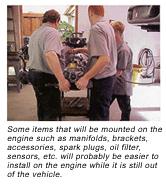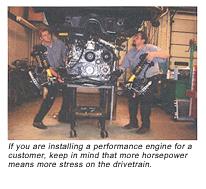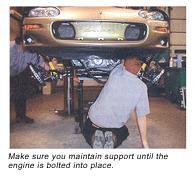Advertisement [ ? ]
Site Links
- Lease Calculator
- Advertise
- My Car ongoing Review
- Members' Chat
- Cars For Sale
- Car Dealers
- Honda "Fit" Manual
- Hyperflex Bushings
- For Sale
- Fix your Car
- Car Manuals
- other manuals - Reference Materials
- DIY Repairs
- Articles
- Video
- Link with Us
- Search Help
- Code your Mac!
- Fly, race, anything R/C
Replace Engine
 Repowering is what engine remanufacturers call it. Replacing an engine with a new, remanufactured engine or rebuilt engine can add years to a vehicle's life and save thousands of dollars over what it might cost to buy another vehicle.
Repowering is what engine remanufacturers call it. Replacing an engine with a new, remanufactured engine or rebuilt engine can add years to a vehicle's life and save thousands of dollars over what it might cost to buy another vehicle.
Zero percent financing and factory rebates can make a new car or truck seem very attractive. But when you add it all up, it is almost always cheaper to keep an existing vehicle even if it requires major repairs.
Replacing an engine is obviously a major repair that requires a sizable investment in a vehicle. For some older vehicles, the cost of replacing the engine may be more than the vehicle is worth. Yet many owners will have the engine replaced anyway because they do not want to trade vehicles or they owe too much on the vehicle to trade it.
An engine that is properly maintained with regular oil and filter changes, changing the spark plugs, timing belt and coolant at specified intervals, etc., should last 100,000 to 150,000 miles or more. But many engines are not properly maintained. Oil and filter changes are put off too long. The coolant is never changed. Nobody remembers to replace the timing belt. Consequently, after thousands of miles of neglect, the engine falters or suffers a variety of fatal ills. It starts to burn oil. It fouls spark plugs and misfires. It burns a valve. It overheats. It blows a head gasket. The head cracks. The oil pressure drops dangerously low. Warning lights come on. It makes rapping, clattering, ticking noises. It is hard to start. It seizes up and refuses to run.
When the engine finally reaches the end of the road, a painful choice has to be made: spend whatever it takes to fix or replace the original engine, or get rid of the vehicle and buy another. Either way it is going to cost money. A car dealer won't give much for a trade-in that has a bad engine. The only way to get rid of a car or truck with a bad engine is to junk it or sell it as a mechanic's special or fixer-uppper. Either way, it won't sell for much money.
Replacing the engine on a vehicle that is more than 12 to 14 years old is usually not worth the cost, unless the vehicle is a classic, an antique or has special value. Engine replacement makes the most economic sense on vehicles that are four to 12 years old, and are still in good condition and worth repairing.
REPLACE ENGINE OR HAVE THE ENGINE REBUILT?
The first step in replacing an engine is to confirm the old engine is beyond fixing or requires so much labor to repair that it is better to replace it. Many internal problems can be repaired without having to completely overhaul the engine - provided the rest of the engine is still in relatively good condition. That includes replacing a blown head gasket, a broken or rounded camshaft, a cracked piston, worn valve guides, burned or bent valves, a cracked head or even a spun bearing. But if the block is cracked, can't be repaired without major machine work or has to be completely disassembled, the cost of parts and labor may tip the scale in favor of replacing the engine.
Replacement options include a used engine from a salvage yard (risky but usually the cheapest alternative), a remanufactured engine (short block or long block), or a new "crate" engine from the original equipment manufacturer. Good used engines for many vehicles are hard to find, and the salvage yard warranty rarely covers installation labor. A safer bet is to replace the old engine with a new or remanufactured engine tha tis backed by a performance warranty as well as an installation labor warranty.
REPLACEMENT ENGINES and EMISSIONS COMPLIANCE
One thing you have to keep in mind with all late-model engine installations is emissions compliance. The replacement engine must be identical to the original so all the required emissions controls and sensors can be installed the same as before. Some engines may have special camshafts, heads or pistons that require a perfect match to meet emissions. Close enough may not be good enough on some of these applications.
Also note, if you are buying a used engine or a remanufactured engine from an offshore supplier for an import vehicle, the engine many not be equipped with U.S emission controls or have the same sensor hookups as your old engine. This can sometimes cause installation issues, or may prevent you from passing an emissions test. So make sure the engine either meets U.S. emission rules, or can be easily modified to accept the same sensor and emission control hookups as your old engine BEFORE you buy it.
ENGINE PERFORMANCE UPGRADES
Another option to consider when replacing an engine is upgrading performance. If more horsepower is wanted, various performance modifications and add-ons may be included, such as a hotter camshaft, higher compression pistons, a performance intake manifold, stroker crankshaft, oversized pistons, or aftermarket cylinder heads with larger valves, etc.
Another option is to install a ready-to-run "crate" engine. Many engine builders offer mild to wild performance engines that are built to almost any specifications. Crate engines typically cost 20 to 25% less than custom built engines, and are available online and from a variety of sources. The engine may be a long block with or without valve covers and oil pan, or it may include an intake manifold, water pump and carburetor or fuel injection system.
For street use, a stage 1 upgrade typically includes a hotter cam, more compression, bigger valves and/or slightly modified head(s), and add 50 to 70 horsepower over the stock engine. A Stage 2 upgrade might bump up the horsepower 70 to 100 hp or more, while a stage 3 or 4 would be more of a serious performance engine.
If you are installing a performance engine, keep in mind that more horsepower means more stress on the drivetrain and cooling system. Additional upgrades also may be needed to handle the extra power such as a larger radiator, beefed up transmission or clutch.

Another benefit of buying a crate engine is no waiting for a machine shop to disassemble, clean, inspect, remachine and rebuild your old engine (a process that often takes up to a week or more depending on the workload in the shop). The only delay with a crate engine is the time it takes the warehouse distributor or engine rebuilder to ship you the engine (which typically adds $150 to $300 to the cost). Many create engines are sold outright with no exchange needed, but others do involve a core charge of $300 to $500 or more if you are not returning your old engine.
WHAT YOU GET WITH A CRATE ENGINE
The sky is the limit as to how much you can spend on a performance crate engine. The price of a performance crate engine typically starts a little higher than that of a stock replacement engine, and goes up exponentially depending on how many cubic inches and how much horsepower and torque you want. If you want a 603 cubic inch Chevy big block V8 that makes 850 plus horsepower, it's only a matter of writing a bigger number on your check. The large displacement, high horsepower custom-built crate engines typically start around $9000 and go up from there. But most of the Ford and Chevy factory built performance crate engines are in the $5000 to $8000 range.
A popular upgrade for a stock 350 Chevy V8 is a 383 stroker motor that includes a longer stroke crankshaft that produces 340 to 400 or more horsepower depending on the cylinder heads, camshaft and compression ratio). The cost may range from $3000 for a "budget" version of the engine up to $7000 or more for a ready-to-race motor built with top quality, name brand aftermarket racing parts.
Other factors that affect the selling price of a performance crate engine include the labor that goes into blueprinting and machining the cylinder heads (ccing the combustion chambers, porting, flow testing, etc.), special work done on the block (grinding to increase clearances for a stroker crank, replacing pressed-in oil plugs with threaded plugs), balancing (which includes adding heavy metal on a stroker crank), line boring, milling, stress relieving or other special procedures that would not usually be done to a stock engine. The more time and effort that goes into prepping and building the engine, the higher its price -- and the better its performance and durability (hopefully!).
Many (but not all) performance crate engines are dyno tested after they have been assembled. Dyno testing allows the engine builder to make sure everything was put together correctly and the engine has proper compression and oil pressure. It also allows them to control the critical engine break-in process (which reduces warranty problems). It also allows them to verify the engine's power output. The dyno sheet that comes with the engine shows its actual torque and horsepower curves, which is much more credible than advertising claims in a sales brochure.
BEFORE THE ENGINE IS INSTALLED
Before you roll the engine hoist into place to drop in the new or rebuilt motor, here are some things that should be done or checked before the engine is installed:
- Check the motor mounts. Replace if they are worn, loose or cracked. If the engine has fluid-filled hydroelastic motor mounts, check for leaks. Replacing same with same is recommended if the mounts are leaking to minimize vibration and harshness.
- Check the condition of the clutch or torque converter, transmission, CV joints, U-joints, etc., and make any repairs as needed.
- Some items that will be mounted on the engine such as manifolds, brackets, accessories, spark plugs, oil filter, sensors, etc. will probably be easier to install on the engine while it is still out of the vehicle. Preassemble as much as you can, then finish the rest of the items once the engine is in place.
- Install new belts and hoses (also, check automatic tensioners and idler pulleys and replace as needed).
- Install new oxygen sensor(s). This is highly recommended on high-mileage engines to guarantee proper fuel feedback control, good fuel economy and emissions compliance.
- Install a new coolant temperature sensor and thermostat. This also is highly recommended to reduce the risk of overheating and possible engine damage.
- Install new spark plugs, plug wires, distributor cap and rotor (if equipped). Platinum long-life spark plugs are recommended.
- Scan the computer for fault codes, fix any problems as needed, and clear the code memory.
- Check for any PCM flash updates that may be available from the OEM and reflash the computer as needed.
- Check for any engine-related technical service bulletins that are out on the vehicle, and make any upgrades or changes as recommended.

INSTALL ENGINE
When the engine is ready to be installed, carefully lower or raise it into position being careful to align the motor mounts, engine cradle and transmission. Maintain support until the engine is bolted into place.
- Tighten all motor mounts, bellhousing bolts, manifold bolts, brackets, cradle bolts, etc. to specifications.
- Make sure all hoses are properly routed (refer to the emissions decal or a manual if you need help), and all hose clamps are tight.
- When reattaching wires, make sure the connectors are free from corrosion and fit tightly (repair or replace as needed). Use dielectric grease where needed to keep moisture out of connectors. Make sure all wires are properly supported and routed away from the exhaust manifolds and spark plug wires.
- When reattaching the throttle cable or linkage, don't forget the return springs. Replace the springs if they are weak or corroded.
- Flush the radiator and change the coolant. Refill with a 50/50 mix of fresh antifreeze and distilled water. A long-life antifreeze is recommended for maximum protection.
- Flush the oil cooler (if equipped). If the original engine had a bearing failure, replace the oil cooler to eliminate any risk of a repeat failure due to metallic debris in the oil cooler or lines.
- Install a new air filter, fuel filter and oil filter.
- Don't forget to fill the oil pan with the proper amount of oil (usually four quarts but may be more or less on some engines). Check the dipstick after filling to make sure it reads accurately. On overhead cam engines, 5W-30 oil is usually recommended so the oil will reach the upper camshaft and upper valvetrain components faster after startup (especially important during cold weather). Note: Some experts do not recommend using a synthetic oil for the initial break-in, and prefer to use a conventional motor oil.
- Check battery charge and condition. The battery should be fully charged before the engine is started. Also, make sure the battery cables are clean and tight. And do not forget to check engine ground straps.
- Make sure you do not have any "leftover" parts.

ENGINE STARTUP AND BREAK-IN
- Once the engine has been installed and refilled with oil and coolant, the fuel lines, emissions hoses and wires are all reconnected and the throttle linkage and return springs are in place, you are ready to start it. WARNING: Do not start the engine in an enclosed garage. Open the door or start it outdoors to avoid carbon monoxide poisoning.
- To reduce the risk of a dry start damaging a newly rebuilt engine, prime the oil system before cranking the engine. This can be done by removing the distributor (if it has one) and turning the oil pump with a long screwdriver blade in an electric drill, or by pressurizing the oil system through the oil sending unit port with equipment designed for this purpose.
- With new and rebuilt engines, run the engine at 1,500 to 2,400 rpm for 20 to 30 minutes, varying the engine speed to break in the camshaft as required. Do not let it idle.
- After the initial break-in, let the engine idle and make any engine adjustments that may be required (ignition timing, idle speed, idle mixture, valve lash, transmission throttle cable, etc.). If the computer has any special "learning" requirements, follow the procedure as outlined to recalibrate/reset the computer.
- Check all the gauge readings (oil pressure, coolant temperature and charging) to make sure they are functioning and reading within normal ranges.
- Make sure the engine reaches and maintains normal operating temperature (check for proper cooling fan operation).
 TEST DRIVE
TEST DRIVEDon't skip this step! A test drive is absolutely essential to make sure the new engine runs smoothly and performs normally. The test drive should include idling, light acceleration, deceleration and cruising at various speeds. Go easy on the throttle the first 50 to 100 miles.
During the test drive:
- Check for hesitation, knocking or misfiring when accelerating.
- Check for smooth and steady cruise conditions (no surging, misfiring).
- Check for backfiring during deceleration. Also check the rear view mirror for blue or white smoke from the tailpipe (there should be none if the rings are seating properly).
- Check for smooth idle when stopped (no stalling, rough idle).
- Listen for any unusual noises (leave the radio off and roll down the window so you can hear the engine clearly).
- Note any unusual odors (there may be some smell from fresh paint but you should not smell gasoline, antifreeze or oil burning).
- Check the operation of the cruise control system (if equipped).
- Check the operation of the heater and A/C (if equipped).
- Shut off the engine and restart it at least twice to make sure it starts normally.
- Recheck the oil level, coolant level, belt adjustments, etc. to make sure everything is okay. Also look underneath to make sure nothing is leaking.
- Take it easy for the first few hundred miles, and change the oil and filter at 500 miles (and every 3,000 to 5,000 miles thereafter).
According to the Engine Repower Council, there are numerous benefits to rebuilding an engine:
- Economic Benefits - There are many hidden costs involved in purchasing a new or a used vehicle (taxes, finance charges, higher insurance rates and vehicle depreciation). You can usually save money rebuilding the engine in an existing vehicle compared to trading vehicles.
- Environmental Benefits - A rebuilt engine is better for the environment because it will emit fewer pollutants, get better gas mileage and save the energy that would normally be required to process a discarded engine or a discarded vehicle.
- Improved Engine Quality - Rebuilt engines usually contain many new components and replacement parts that meet or exceed engine performance standards.
- Warranty Programs - Rebuilt engines come with great warranties, ranging from one year/12,000 miles up to three years/36,000 miles.
Adapted from an article written by Larry Carley for Underhood Service magazine
